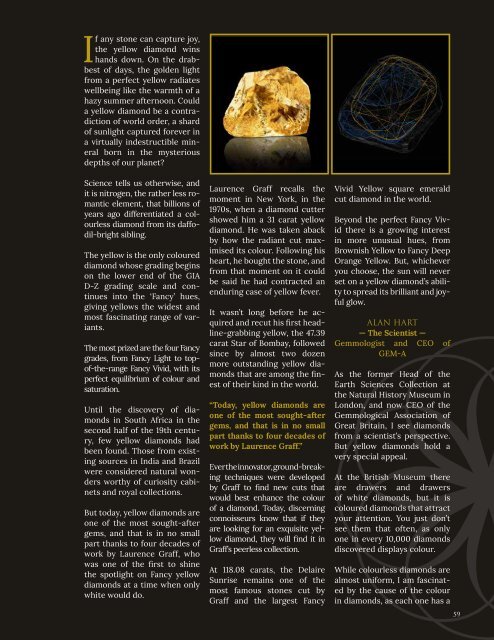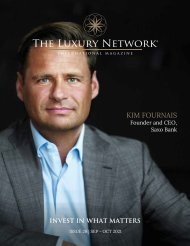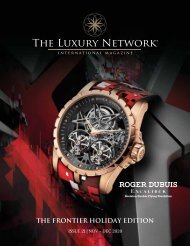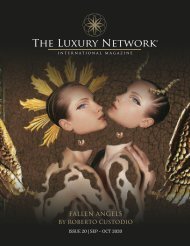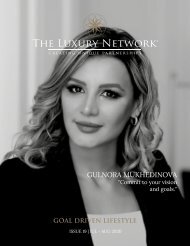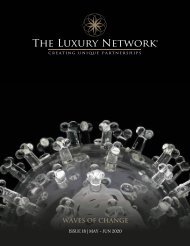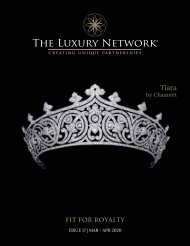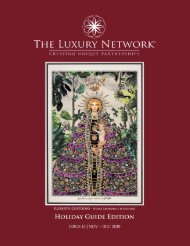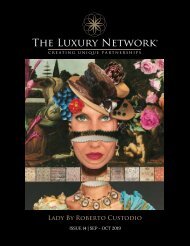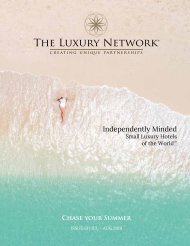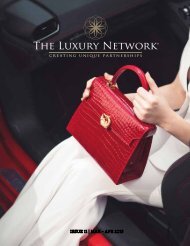You also want an ePaper? Increase the reach of your titles
YUMPU automatically turns print PDFs into web optimized ePapers that Google loves.
If any stone can capture joy,<br />
the yellow diamond wins<br />
hands down. On the drabbest<br />
of days, the golden light<br />
from a perfect yellow radiates<br />
wellbeing like the warmth of a<br />
hazy summer afternoon. Could<br />
a yellow diamond be a contradiction<br />
of world order, a shard<br />
of sunlight captured forever in<br />
a virtually indestructible mineral<br />
born in the mysterious<br />
depths of our planet?<br />
Science tells us otherwise, and<br />
it is nitrogen, the rather less romantic<br />
element, that billions of<br />
years ago differentiated a colourless<br />
diamond from its daffodil-bright<br />
sibling.<br />
<strong>The</strong> yellow is the only coloured<br />
diamond whose grading begins<br />
on the lower end of the GIA<br />
D-Z grading scale and continues<br />
into the ‘Fancy’ hues,<br />
giving yellows the widest and<br />
most fascinating range of variants.<br />
<strong>The</strong> most prized are the four Fancy<br />
grades, from Fancy Light to topof-the-range<br />
Fancy Vivid, with its<br />
perfect equilibrium of colour and<br />
saturation.<br />
Until the discovery of diamonds<br />
in South Africa in the<br />
second half of the 19th century,<br />
few yellow diamonds had<br />
been found. Those from existing<br />
sources in India and Brazil<br />
were considered natural wonders<br />
worthy of curiosity cabinets<br />
and royal collections.<br />
But today, yellow diamonds are<br />
one of the most sought-after<br />
gems, and that is in no small<br />
part thanks to four decades of<br />
work by Laurence Graff, who<br />
was one of the first to shine<br />
the spotlight on Fancy yellow<br />
diamonds at a time when only<br />
white would do.<br />
Laurence Graff recalls the<br />
moment in New York, in the<br />
1970s, when a diamond cutter<br />
showed him a 31 carat yellow<br />
diamond. He was taken aback<br />
by how the radiant cut maximised<br />
its colour. Following his<br />
heart, he bought the stone, and<br />
from that moment on it could<br />
be said he had contracted an<br />
enduring case of yellow fever.<br />
It wasn’t long before he acquired<br />
and recut his first headline-grabbing<br />
yellow, the 47.39<br />
carat Star of Bombay, followed<br />
since by almost two dozen<br />
more outstanding yellow diamonds<br />
that are among the finest<br />
of their kind in the world.<br />
“Today, yellow diamonds are<br />
one of the most sought-after<br />
gems, and that is in no small<br />
part thanks to four decades of<br />
work by Laurence Graff.”<br />
Ever the innovator, ground-breaking<br />
techniques were developed<br />
by Graff to find new cuts that<br />
would best enhance the colour<br />
of a diamond. Today, discerning<br />
connoisseurs know that if they<br />
are looking for an exquisite yellow<br />
diamond, they will find it in<br />
Graff’s peerless collection.<br />
At 118.08 carats, the Delaire<br />
Sunrise remains one of the<br />
most famous stones cut by<br />
Graff and the largest Fancy<br />
Vivid Yellow square emerald<br />
cut diamond in the world.<br />
Beyond the perfect Fancy Vivid<br />
there is a growing interest<br />
in more unusual hues, from<br />
Brownish Yellow to Fancy Deep<br />
Orange Yellow. But, whichever<br />
you choose, the sun will never<br />
set on a yellow diamond’s ability<br />
to spread its brilliant and joyful<br />
glow.<br />
ALAN HART<br />
— <strong>The</strong> Scientist —<br />
Gemmologist and CEO of<br />
GEM-A<br />
As the former Head of the<br />
Earth Sciences Collection at<br />
the Natural History Museum in<br />
London, and now CEO of the<br />
Gemmological Association of<br />
Great Britain, I see diamonds<br />
from a scientist’s perspective.<br />
But yellow diamonds hold a<br />
very special appeal.<br />
At the British Museum there<br />
are drawers and drawers<br />
of white diamonds, but it is<br />
coloured diamonds that attract<br />
your attention. You just don’t<br />
see them that often, as only<br />
one in every 10,000 diamonds<br />
discovered displays colour.<br />
While colourless diamonds are<br />
almost uniform, I am fascinated<br />
by the cause of the colour<br />
in diamonds, as each one has a<br />
59


